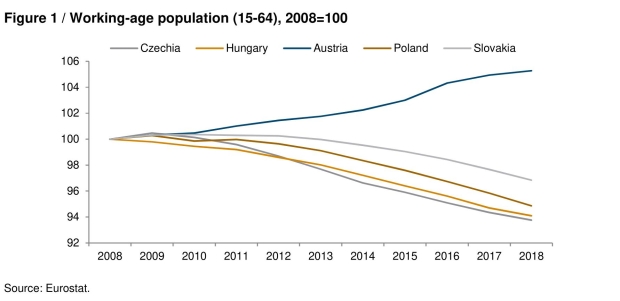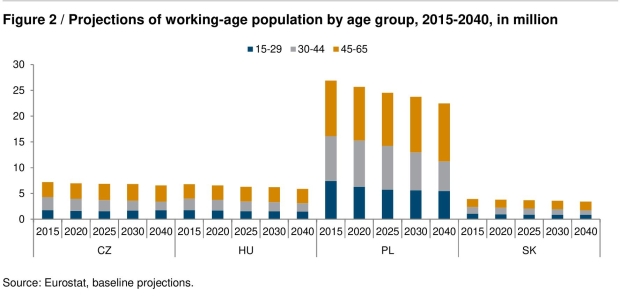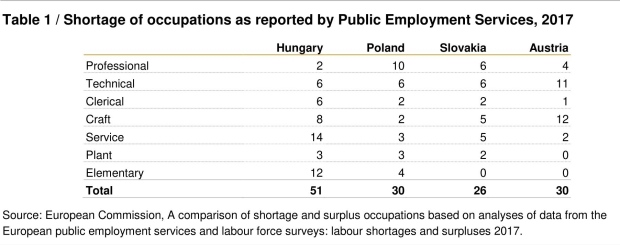Labour market improvements in the Visegrád countries: a mixed blessing for Austria
02 October 2019
So far, the economic effects of the shrinking working-age population were mostly positive. But reduced migration from the V4 to Austria is likely to aggravate labour and skills shortages.
By Vasily Astrov
Photo: iStock.com/smartstock
- The working-age population in the Visegrád countries is expected to shrink further due to population ageing, low birth rates, rising mortality rates and, in the case of Poland, outward migration.
- This trend has contributed to a dramatic decline in unemployment and a robust growth of real wages over the past few years.
- However, unless offset by increased automation, the growing labour shortages might become a constraint on economic growth in the near future.
- Although the high economic growth in the region offers ample trade and investment opportunities for Austrian companies, the reduced migration flows to Austria will aggravate the problem of labour and skills shortages in it.
In the new wiiw Policy Note “Labour Market Trends in Visegrád Countries: Implications for Austria”, the economic developments in the Czech Republic, Hungary, Poland and Slovakia are viewed against the background of secular trends of population ageing and, in some cases, outright population decline.
Over the past decade, the Visegrád countries experienced a significant decline of their working-age population, ranging between 3.2% in Slovakia and 6.2% in the Czech Republic (Figure 1).
Under plausible assumptions, these trends are expected to persist over the next few decades, as low birth rates and rising mortality rates – reinforced by outward net migration in the case of Poland – will result in the working-age populations shrinking further.
The breakdown by age groups in Figure 2 shows that the young and medium-age groups (15-44) are likely to shrink markedly while the older population aged 45-65 is expected to increase. Poland in particular will experience a rapid decline in the working-age population by an estimated 16.5 percent between 2015 and 2040. In Hungary and Slovakia, the decline is expected to be at 12 to 13 percent and in the Czech Republic at 9 percent. These trends suggest that it is the younger working-age population above all which will decline. This, in turn, implies that the working-age population of Visegrád countries will not only be shrinking, but also ageing.
Economic effects and strategies
Paradoxically, the deepening labour shortages have had predominantly positive macro-economic effects, at least so far. First, they have improved the bargaining power of employees, resulting in strong real wage growth – the main pillar of growth in private consumption, as wages are the most important source of household incomes in the Visegrád countries. Second, they have had important second-round effects, as improved sales prospects encourage investments, often resulting in higher labour productivity and hence further wage increases. These feeds and loops have created a virtuous circle of positive supply and demand shocks, resulting in relatively high economic growth. This applies particularly to Hungary and Poland, which (along with Romania) have recorded the highest GDP growth rates among EU Member States over the past two years.
However, while the labour shortages were generally manageable so far, they will potentially limit the countries´ further growth prospects. The Policy Note discusses various strategies to potentially avert this problem - ranging from accepting higher immigration to increasing activity rates and fertility. But the most promising avenue and ultimate recommendation is to increase labour productivity through increased investments in automation and robotisation.
Implications for Austria
The implications of these developments for Austria are likely to be two-fold. On the one hand, the above-average economic growth in the Visegrád countries is welcome news for Austria as it will offer more trade and investment opportunities for Austrian companies. The track record of increased economic cooperation with these countries so far has been, by and large, positive for Austria. On the other hand, the shrinking working-age population in the Visegrád countries and their ongoing catching-up, inter alia in terms of wages and social benefits, imply that labour migration flows from these countries to Austria, which has been sizeable up to now, will likely subside, aggravating the problem of labour and skills shortages in Austria (Table 1).
Measures offsetting the rising labour and skill shortages in Austria could include, for instance, training programs and apprenticeships, supported by fiscal measures such as tax benefits and targeted subsidies. In the longer term, mitigating labour force shortages in Austria would require policies such as improving training in technical and craft occupations as well as subsidising investments in labour-saving technologies which could offset the effects of a shrinking working-age population on economic growth.



